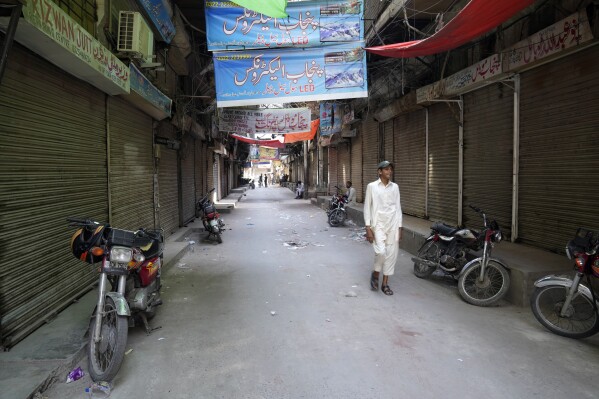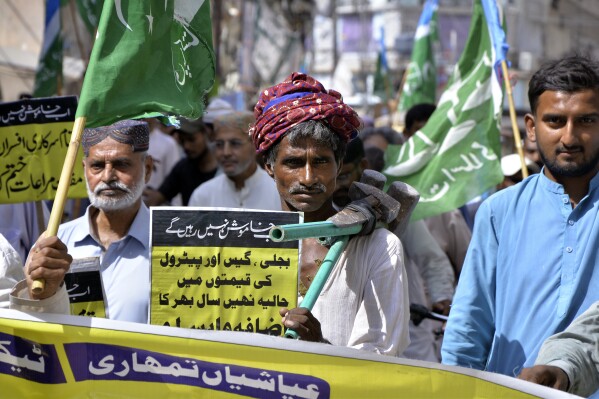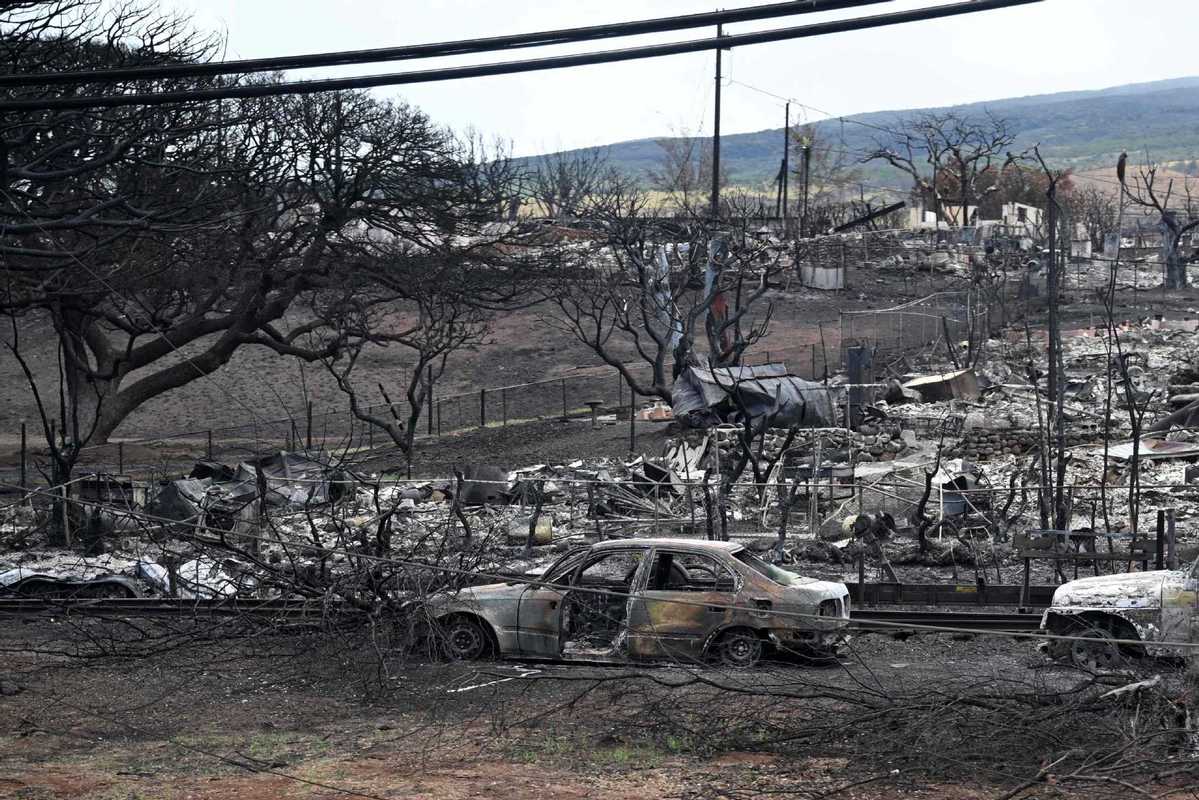Pakistani traders strike countrywide against high inflation and utility bills

Pakistani shopkeepers close their businesses during strike against inflation in Lahore, Pakistan, Saturday, Sept. 2, 2023. Pakistani traders on Saturday went on strike against the soaring cost of living, including higher fuel and utility bills and record depreciation of the rupee against the dollar, which has led to widespread discontent among the public. (AP Photo/K.M. Chaudary)Read More

Supporters of Jamaat-e-Islami chant anti-Pakistan government during a strike against inflation in Hyderabad, Pakistan, Saturday, Sept. 2, 2023. Pakistani traders on Saturday went on strike against the soaring cost of living, including higher fuel and utility bills and record depreciation of the rupee against the dollar, which has led to widespread discontent among the public. (AP Photo/Pervez Masih)

Pakistani shopkeepers close their businesses during strike against inflation in Karachi, Pakistan, Saturday, Sept. 2, 2023. Pakistani traders on Saturday went on strike against the soaring cost of living, including higher fuel and utility bills and record depreciation of the rupee against the dollar, which has led to widespread discontent among the public. (AP Photo/Fareed Khan)

BY ZARAR KHAN
September 2, 2023
ISLAMABAD (AP) — Pakistani traders on Saturday went on strike against the soaring cost of living, including higher fuel and utility bills and record depreciation of the rupee against the dollar, which has led to widespread discontent among the public.
The traders pulled their shutters down across the country, while protesters burned tires on roads to express their anger.
The strike was called by ex-senator Sirajul Haq, who heads the religious political party Jamaat-e-Islami, and it was largely endorsed by trade and business bodies, market associations, lawyers associations and transporters.
The country’s commercial and economic hub, Karachi, was almost completely closed and vehicle traffic was thin on roads, with all markets and shopping centers closed.
“We have shut our shops in protest so that our message reaches the ruling class. If they don’t consider our problems, we will devise further strategies, said Fahad Ahmed, a trader in Karachi, adding, “If you pay 100,000 rupees ($330) in rent for your shop and you have to pay an equal amount in electricity bill, how can you survive?”
In the eastern city of Lahore, the capital of Punjab province, all the main markets were closed for the day, lawyers remained out of courts and intercity and local public transport weren’t operating. The northwestern city of Peshawar and southwestern city of Quetta were partially closed.
Pakistan’s annual inflation rate was 27.4% in August, according to data released by the state-run Bureau of Statistics.
Pakistan was on the verge of default before securing a lifeline deal with the International Monetary Fund. As part of the conditions for the bailout package, Pakistan was required to reduce subsidies that had been in place to cushion the impact of rising living costs. This likely contributed to the increase in prices, especially energy costs.
Mohammad Sohail, a prominent economist and head of Topline Securities, said that in spite of the IMF program Pakistan is going through a challenging time. He said the government is trying to implement the painful IMF-dictated reforms while political polarization is affecting sentiments.
“Inflation is a big problem for common Pakistanis. And this inflation is mainly led by the falling rupee. Strict stabilization measures with improving foreign exchange reserves can stabilize the currency and inflation going forward,” Sohail said.
The value of the Pakistani rupee has significantly depreciated against the dollar, crossing a historic threshold of 300 rupees to the dollar. Exchange rate depreciation has led to higher import costs which in turn can contribute to inflation.
Jamal Uddin, a shopkeeper who was participating in a protest rally in Dera Ghazi Khan, said he and other traders were keeping their businesses shut in protest because it simply wasn’t possible anymore for them to feed their families.
Shamim Bibi, a widow and mother of three in Multan, said that her daughters had to quit school and her young son went to run a food stall to meet the daily needs of the family.
“But now our life is miserable due to extremely inflated electricity bills, high fuel and food prices and increasing house rent,” she said.
But the caretaker prime minister, Anwaarul Haq Kakar, downplayed the significance of the protests, referring to the complaints as a “nonissue.”
___
Mohammad Farooq in Karachi, Babar Dogar in Lahore, Asim Tanveer in Multan, Riaz Khan in Peshawar and Abdul Sattar in Quetta, contributed to this report.
Power failurePublished September 4, 2023

PRESSURE is mounting on the caretaker government and the establishment on multiple fronts — political, economic and legal. Several developments have fuelled more uncertainty at a time when the country is already in a tense and unsettled state. This has created the prospect of greater instability ahead. The conflation of crises could even push the country towards a tipping point.
Nationwide street protests by traders and members of the public over the sudden and excessive rise in electricity bills have confronted the government with a challenge. It is now struggling for a response that can quell the protests but also not upend the stand-by agreement with the IMF, which provided the financial bailout the country needed to avert a debt default.
While talks with Fund representatives are underway to find a way to provide ‘relief’ to consumers, protests continue across the country.
These protests come on the back of a cost-of-living crisis fuelled by record inflation — mostly the result of economic mismanagement by governments in the recent past. This has worsened people’s plight in a deteriorating economic environment and bred widespread public discontent.
It was always a question of not if but when this discontent would spill over into the streets. The spark was provided by the exorbitant hike in utility charges. These protests can snowball into wider social unrest if other issues of public grievance — there are many — kick in. Such a potentially explosive situation would be beyond the interim government’s capacity to control.
When people see no hope of improvement in their economic condition, it is hard to douse the flames of their anger. What has contributed to public rage is the fact that they are being asked to bear the burden of governance failures — mismanagement of the power sector by successive governments, failure to deal with its inefficiencies, and lack of reform.
Added to this is a glaring inequity. Certain sectors are exempt from additional electricity taxes, while several categories of state officials receive preferential treatment by way of free electricity. There cannot be a more telling example of a policy that only privileges the elite while the public pays the price. With the rise in petroleum prices and more painful measures ahead, public discontent is likely to intensify, not dissipate.
Already, cities across the country have seen a complete shutter-down strike by retail establishments in response to a call by the traders’ association. Such strikes have obvious economic consequences.
The conflation of crises can push the country to a tipping point.
Meanwhile, political pressure is growing for elections to be held in 90 days, as stipulated by the Constitution. Last month, the Election Commission of Pakistan ruled this out when it issued a schedule indicating it needed four months for fresh delimitation of constituencies, which it said it would complete in mid-December. This followed approval of the new population census, secured by the PDM government from the Council of Common Interests in its final days in power. The ECP’s decision to delay general elections and not specify a date prompted speculation that the polls could be pushed to February and even beyond. Uncertainty was also fuelled by installation of a gratuitously large caretaker government that began to act as if it were anything but a short-duration arrangement.
The election delay predictably provoked an outcry from several political parties, as well as a spate of legal challenges. Imran Khan’s PTI and the PPP demanded elections within the 90-day time frame. The PPP was party to the unanimous CCI decision on the digital census. Its latest stance suggested it has doubts on whether elections will even be held after completion of the delimitation process. Its U-turn is also an effort to distance itself from its former coalition partner, PML-N.
A cynical explanation is that PPP is mounting pressure in response to administrative actions taken against some of its sympathisers, hoping the establishment will remedy this. In any case, this has left PML-N isolated as the only major party that wants a delay in elections. This signals a lack of confidence in its electoral prospects, especially after Shehbaz Sharif’s lacklustre tenure.
The Supreme Court Bar Association has filed a constitutional petition in the apex court that seeks suspension of the ECP decision to hold elections on the new census. It points to the ECP’s responsibility to convene elections within 90 days of the Assembly’s dissolution. The Bar Council of Pakistan has made a similar demand. PTI and Jamaat-i Islami also filed petitions in the top court seeking general elections within 90 days as mandated by Article 224(2) of the Constitution.
While a legal battle looms, it also puts pressure on the interim government to weigh in on this even though that decision is for its patrons to take. The government’s response through the law ministry to President Arif Alvi’s letter to ECP asking for an election date questioned his authority to do this. But it skirted around the issue of when the polls should be called. During a meeting with journalists, Prime Minister Anwar-ul-Haq Kakar simply said it was for ECP to decide the timing.
For its part, the Supreme Court dismissed ECP’s plea for review of the Punjab election order last week, and made it clear it will not accept any transgression from the Constitution. Its ruling reiterated that elections within 90 days was a constitutional requirement. The chief justice said the court will intervene if there is any violation. The court verdict has intensified pressure on ECP to announce a schedule for general elections. So far, ECP’s response has been to shorten the time frame for the delimitation process to end-November without issuing a new schedule.
Not announcing an election date has become a source of growing political controversy and legal contention. Doubts persist that elections may not even be held by February/ March. This is deepening polarisation in the country and having a damaging fallout on the economy. More uncertainty will raise the cost to an economy that is already on life support.
It will continue to produce instability in the capital market, vitiate the investment climate, encourage capital flight and delay any significant economic policy decisions. Whether or not the authorities realise this, it puts Pakistan’s economic future at grave risk.
The writer is a former ambassador to the US, UK and UN.
Published in Dawn, September 4th, 2023













